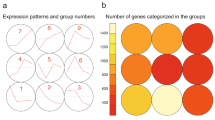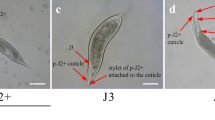Abstract
Of all the economically important plant parasitic nematodes, root-knot nematodes (Meloidogyne species) are amongst the most widespread, the best recognized and most widely studied. This is partly because infected roots develop galls where the nematodes feed, which with severe infection give roots a ‘knotted’ appearance. They have a remarkably wide host range, and are ubiquitous especially in tropical and sub-tropical regions of the world. Juveniles move through the soil rhizosphere and locate host roots, in which they migrate intercellularly to pro-vascular cells to form a feeding site. Here, in response to nematode secretions, they re-program the development of about 6 cells into ‘giant cells’, which provide them with the nourishment needed for them to complete their life cycle of about 4–5 weeks. Giant cells form by repeated mitosis without cytokinesis, and so become multi-nucleate. Wall ingrowths typical of transfer cells develop both where giant cell walls contact vascular elements and between neighbouring giant cells. These amplify the surface area of the cell membrane and enable solutes and water to enter the cells, and to move between giant cells in response to nematode feeding. The developing giant cells become filled with cytoplasm, prominent amoeboid nuclei, mitochondria and small vacuoles, and appear to be very active metabolically. Giant cell development is accompanied with a host of changes in gene expression, cytoskeleton changes, plant hormone changes and structural changes. The delicate interaction between the nematode and its associated giant cells is mediated via feeding tubes, derived from nematode gland secretions, which act as an ultrafilter and pressure regulator. As the infective worm-like J2 larvae develop via 3 moults to reach the adult stage, they swell and adult females become spherical, and lays eggs into a gelatinous matrix. Most root-knot nematodes reproduce by mitotic parthenogenesis, although facultative meiotic parthenogenesis also occurs (e.g. in M. hapla). The availability of new molecular technologies that enable detailed study of gene expression and regulation in giant cells, and new genomic technologies applied both to host and nematode pathogen, is leading to rapid advances in understanding host-pathogen interactions of this important plant pest species.
Access this chapter
Tax calculation will be finalised at checkout
Purchases are for personal use only
Similar content being viewed by others
Abbreviations
- DPI:
-
Days Post Infection
- GFP:
-
Green Fluorescent Protein
- RKN:
-
Root-Knot Nematode
- J1:
-
first stage Juvenile
- J2:
-
second stage Juvenile
- NF:
-
Nodulation Factor; other abbreviations defined when first used.
References
Bakhetia M, Charlton WL, Urwin PE, McPherson MJ, Atkinson HJ (2005) RNA interference and plant parasitic Nematodes. Trends Plant Sci 10:632–637
Bellafiore S, Shen Z, Rosso MN, Abad P, Shih P, Briggs S (2008) Direct identification of the Meloidogyne incognita secretome reveals proteins with host cell reprogramming potential. PLoS Pathog 4:e1000192
Bird AF, Loveys BR (1980) The involvement of cytokinins in a host–parasite relationship between the tomato (Lycopersicon esculentum) and a nematode (Meloidogyne javanica). Parasitology 80:497–505
Capoen W, Sofie Goormachtig S, Holsters M (2009) Water-tolerant legume nodulation. J Exp Bot 61:1251–1255
Davis EL, Hussey RS, Baum T (2009) Parasitism genes: what they reveal about parasitism. In: Berg RH, Taylor CG (eds) Cell biology of plant nematode parasitism. Springer, Heidelberg, pp 15–44
de Almeida Engler J, De Vleesschauwer V, Burssens S, Celenza JL, Inzé D, Van Montagu M, Engler G, Gheysen G (1999) Molecular markers and cell cycle inhibitors show the importance of cell cycle progression in nematode-induced galls and syncytia. Plant Cell 11:793–807
de Almeida Engler JJ, Van Poucke K, Karimi M, De Groodt R, Gheysen G, Engler G (2004) Dynamic cytoskeleton rearrangements in giant cells and syncytia of nematode-infected roots. Plant J 38:12–26
Dropkin VH, Acedo J (1974) An electron microscopic study of glycogen and lipid in female Meloidogyne incognita (root-knot nematode). J Parasitol 63:1013–1021
Francis D, Sorrell DA (2001) The interface between the cell cycle and plant growth regulators. Plant Growth Regul 33:1–12
Gheysen G, Mitchum MG (2009) Molecular insights in the susceptible plant response to nematode infection. In: Berg RH, Taylor CG (eds) Cell biology of plant nematode parasitism. Plant cell monographs. Springer-Verlag, Berlin
Goto DB, Fosu-Nyarko J, Sakuma F, Sadler G, Flottman-Reid M, Uehara T, Kondo N, Yamaguchi J, Jones MGK (2010) In planta observation of live fluorescent plant endoparasitic nematodes during early stages of infection. Nematology Res 40:15–19
Goverse A, de Almeida Engler J, Verhees J, van der Krol S, Helder J, Gheysen G (2000) Cell cycle activation by plant parasitic nematodes. Plant Mol Biol 43:747–761
Gunning BES, Pate JS (1974) Transfer cells. In: Robards AW (ed) Dynamic aspects of plant ultrastructure. McGraw-Hill, Maidenhead
Huang G, Gao B, Maier T, Allen R, Davis EL et al (2003) A profile of putative parasitism genes expressed in the esophageal gland cells of the root-knot nematode Meloidogyne incognita. Mol Plant Microbe Interact 16:376–381
Hussey RS (1989) Disease-inducing secretions of plant-parasitic nematodes. Annu Rev Phytopathol 27:123–141
Hutangura P, Mathesius U, Jones MGK, Rolfe BG (1999) Auxin induction is a trigger for root gall formation caused by root-knot nematodes in white clover and is associated with the activation of the flavonoid pathway. Aust J Plant Physiol 26:221–231
Jaubert S, Ledger TN, Laffaire JB, Piotte C, Abad P, Rosso MN (2002) Direct identification of stylet secreted proteins from root-knot nematodes by a proteomic approach. Mol Biochem Parasitol 121:205–211
Jones MGK (1981) Host cell responses to endoparasitic nematodes. Ann Appl Biol 97:353–372
Jones MGK, Dropkin VH (1975) Cellular alterations induced in soybean by three endoparasitic nematodes. Physiol Plant Pathol 5:119–124
Jones MGK, Dropkin VH (1976) Scanning electron microscopy of nematode induced giant transfer cells. Cytobios 15:159–161
Jones MGK, Gunning BES (1976) Transfer cells and nematode-induced giant cells in Helianthemum. Protoplasma 87:273–279
Jones MGK, Northcote DH (1972) Multinucleate transfer cells induced in coleus roots by the root-knot nematode Meloidogyne incognita. Protoplasma 75:381–395
Jones MGK, Payne HL (1978a) The early stages of nematode-induced giant cell formation in roots of Impatiens balsamina. J Nematol 10:70–84
Jones MGK, Payne HL (1978b) Cytokinesis in Impatiens balsamina and the effect of caffeine. Cytobios 20:79–91
Jones MGK, Novacky A, Dropkin VH (1974) ‘Action potentials’ in nematode induced plant transfer cells. Protoplasma 80:401–405
Jones MGK, Novacky A, Dropkin VH (1975) Transmembrane potentials of parenchyma cells and nematode-induced transfer cells. Protoplasma 85:15–37
Joubès J, Lemaire-Chamley M, Delmas F, Walter J, Hernould M, Mouras A, Raymond P, Chevalier C (2001) A new C-type cyclin-dependant kinase from tomato expressed in dividing tissues does not interact with mitotic and G1 cyclins. Plant Physiol 126:1403–1415
Karczmarek A, Overmars H, Helder J, Goverse A (2004) Feeding cell development by cyst and root-knot nematodes involves a similar early, local and transient activation of a specific auxin-inducible promoter element. Mol Plant Pathol 5:324–346
Lohar DP, Schaff JE, Laskey JG, Kieber JJ, Bilyeu KD, Bird DMcK (2004) Cytokinins play opposite roles in lateral root formation, and nematode and rhizobial symbioses. Plant J 38:203–214
Nombela G, Williamson VM, Muñiz M (2003) The root-knot nematode resistance gene Mi-1.2 of tomato is responsible for resistance against the whitefly Bemisia tabaci. Mol Plant Microbe Interact 16:645–649
Offler CE, McCurdy DW, Patrick JW, Talbot MJ (2002) Transfer cells: cells specialized for a special purpose. Annu Rev Plant Biol 54:431–454
Paulson RE, Webster JM (1970) Giant cell formation in tomato roots caused by Meloidogyne incognita and M. hapla (Nematode) infection: A light and electron microscope study. Can J Bot 48:271–276
Ramsay K, Wang ZH, Jones MGK (2004) Using laser capture microdissection to study gene expression in early stages of giant cells induced by root-knot nematodes. Mol Plant Pathol 5:587–592
Rossi M, Goggin FL, Milligan SB, Kaloshian I, Ullman DE, Williamson VM (1998) The nematode resistance gene Mi of tomato confers resistance against the potato aphid. Proc Natl Acad Sci U S A 95:9750–9754
Urwin PE, McPherson MJ, Atkinson HJ (1997) Enhanced transgenic plant resistance to nematodes by dual proteinase inhibitor constructs. Planta 204:472–479
Wasson AP, Ramsay K, Jones MGK, Mathesius U (2009) Differing requirements for flavonoids during the formation of lateral roots, nodules and root knot nematode galls in Medicago truncatula. New Phytol 183:167–179
Weerasinghe RR, David McK, Bird D, Allen NS (2005) Root-knot nematodes and bacterial Nod factors elicit common signal transduction events in Lotus japonicas. Proc Natl Acad Sci U S A 102:3147–3152
Wyss U, Grundler FMW (1992) Feeding behaviour of sedentary plant parasitic nematodes. Eur J Plant Pathol 98:165–173
Wyss U, Zunke U (1986) Observations on the behaviour of second-stage juveniles of Heterodera schachtii inside host roots. Revue Nématol 9:153–165
Yadav BC, Veluthambi K, Subramaniam K (2006) Host-generated double-stranded RNA induces RNAi in plant-parasitic nematodes and protects the host from infection. Mol Biochem Parasitol 148:219–222
Acknowledgements
MJ thanks the EU COST Action 872 program for support to participate in its meetings. Research in the authors’ laboratories is supported by the Australian Research Council (MJ) and the Japanese Ministry of Education, Culture, Sports, Science and Technology (DG).
Author information
Authors and Affiliations
Corresponding author
Editor information
Editors and Affiliations
Rights and permissions
Copyright information
© 2011 Springer Science+Business Media B.V.
About this chapter
Cite this chapter
Jones, M.G., Goto, D.B. (2011). Root-knot Nematodes and Giant Cells. In: Jones, J., Gheysen, G., Fenoll, C. (eds) Genomics and Molecular Genetics of Plant-Nematode Interactions. Springer, Dordrecht. https://doi.org/10.1007/978-94-007-0434-3_5
Download citation
DOI: https://doi.org/10.1007/978-94-007-0434-3_5
Published:
Publisher Name: Springer, Dordrecht
Print ISBN: 978-94-007-0433-6
Online ISBN: 978-94-007-0434-3
eBook Packages: Biomedical and Life SciencesBiomedical and Life Sciences (R0)




